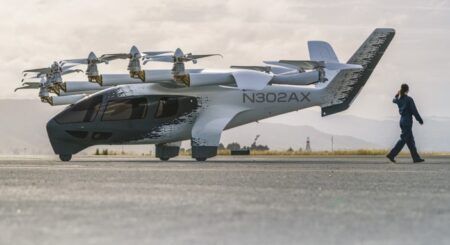The UK’s Air Accident Investigation Branch has slammed the company behind the development of a flying racing car series after one of its demonstrators crashed during an air show.
During the incident in July 2019 at Goodwood Aerodrome, West Sussex the pilot lost control of the 95kg Alauda Airspeeder MKII unmanned demonstrator aircraft and the safety kill switch failed to work. The Airspeeder climbed to around 8,000ft, at which point it was in the controlled airspace of nearby Gatwick Airport, before its battery depleted and it fell into a field of crops, around 40m from occupied houses and 700m (0.5 miles) outside of its designated operating area. Fortunately, there were no injuries.
Australia-based Alauda Aeronautics is making 10 MK3 Airspeeders to run in a series of unmanned races later this year and then plans to run a series of piloted races that will use a MK4 version next year. The electric vertical take-off and landing (eVTOL) octocopters are capable of speeds of up to 120km/h (75mph).
A report published last week by the Air Accident Investigation Branch (AAIB) found that found that the Airspeeder Mk II was not designed, built or tested “to any recognisable engineering or airworthiness standards, and that its design and build quality were poor”. It also found that the operator’s Operating Safety Case contained errors and inaccuracies.
UK regulator the Civil Aviation Authority’s (CAA) had issued an exemption to allow the demonstration flight in accordance with the operator’s Operating Safety Case, but did not inspect the Airspeeder Mk II before doing so.
Crispin Orr, chief Inspector of the AAIB said, “The innovative development of unmanned aircraft systems continues to be rapid, and the exploitation of these technologies in a wide variety of novel applications is remarkable. However, this is not completely without risk to the general public.
“Thankfully there were no injuries caused by this accident but the potential for a more serious outcome was clear. This accident demonstrates why it is so important that manufacturers, operators and regulators of unmanned aircraft ensure they are airworthy and operated in a safe and appropriate manner.
Since the investigation, the CAA and Aluada Aeronautics have introduced measures to address the issues identified, the AAIB said. In addition, as a result of the investigation the AAIB has made several safety recommendations regarding airworthiness standards, safety management and the regulatory oversight of unmanned aircraft systems.
“The investigation has provided a rich opportunity to learn and many safety actions have been taken or recommended to improve the safety of unmanned aviation,” added Orr.




